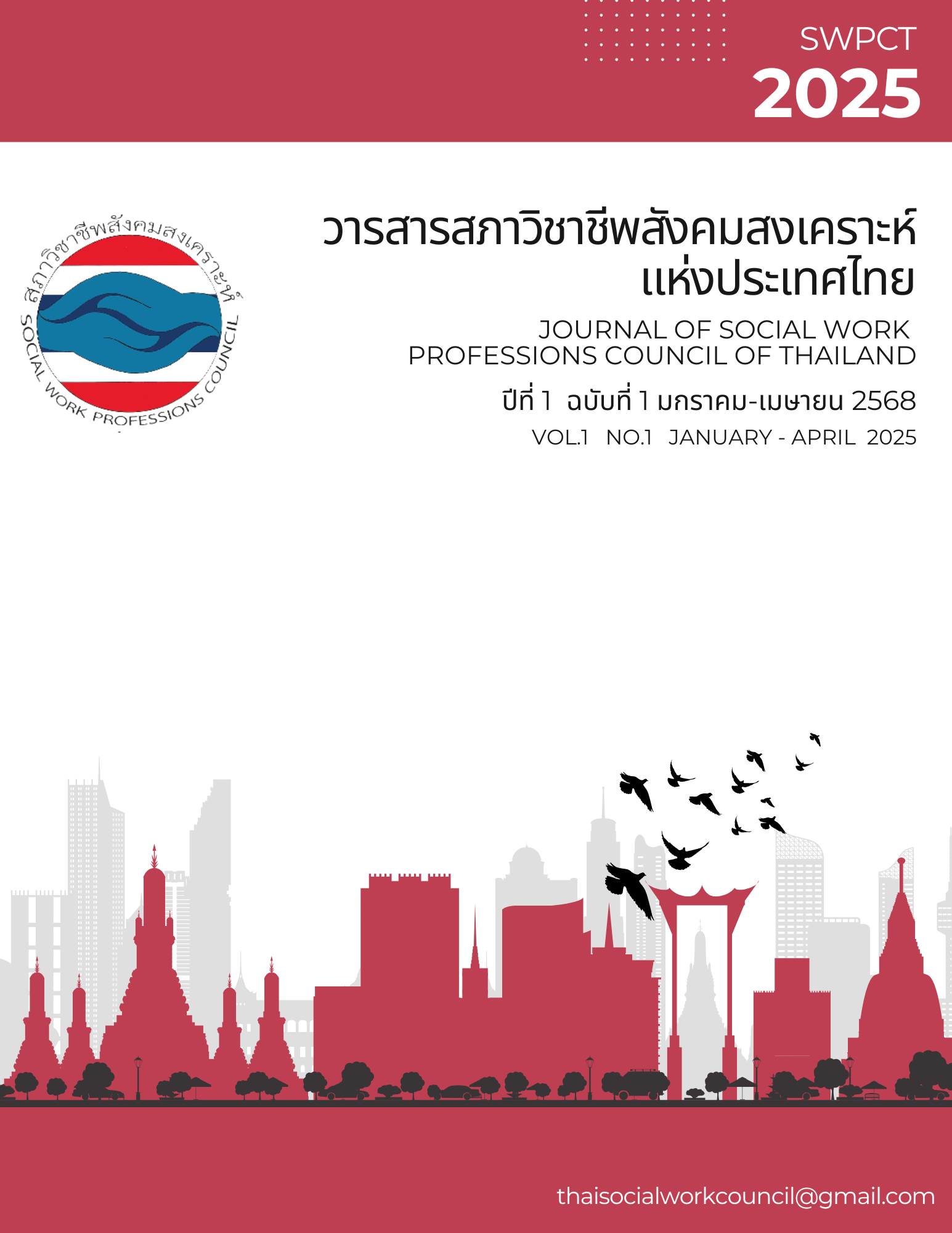Mechanisms and Network Management Models of Local Administrative Organizations for Community-Based Elderly Services: A Case Study of the Strong Model
Abstract
The Strong Model is a form of empowerment and knowledge management network that delivers services for older adults in the community, primarily driven by local administrative organizations. It was developed in response to the growing complexity and dependency of Thailand’s aging population, which calls for greater preparedness. Over three years of implementation, this project has yielded an innovative service model for older adults that is both efficient and well-suited to the unique conditions of each locality. Accordingly, this study aims to investigate the mechanisms and operational model of the Strong Model, which can support 39 local administrative organizations, and to propose guidelines for social management professionals working with the aging population.
The study’s methodology involved hands-on work in the field through applying the Strong Model, interviews with social management professionals for older adults, and analysis of documents from the 39 participating networks. The findings reveal three key mechanisms for network management: (1) Team Building, (2) Network and Mutual Support, and (3) Coach and Strategic Management. These three mechanisms are carried out through three distinct teams within the network: the Core Team, the Coaching Team, and the Strategic Management Team. Each team has its own roles and responsibilities, yet they work together and support one another to learn and adapt to changing contexts.
Furthermore, four critical factors drive effective service provision under this model: (1) Intensive Training, (2) Research Methodology, (3) Mutual Support (in an informal context), and (4) Community-Based Integrated Care. Based on these findings, the study recommends developing in-depth training curricula, encouraging each local administrative organization to produce social management professionals for older adults, and advancing community-based integrated care. It also suggests seeking collaboration with private-sector entities and social enterprises to enhance the sophistication and reach of services for older adults.
Keywords: Mechanisms, Network Management Model, Local Administrative Organizations, Older Adult Service Provision
References
กรมกิจการผู้สูงอายุ. (2567). สถานการณ์ผู้สูงอายุไทย พ.ศ. 2566. กรุงเทพฯ: กรมกิจการผู้สูงอายุ กระทรวงการพัฒนาสังคมและความมั่นคงของมนุษย์.
ชัยอนันต์ สมุทวณิช. (2542). ประชารัฐกับการเปลี่ยนแปลง. กรุงเทพฯ : สถาบันนโยบายศึกษา.
ณัฏฐพัชร สโรบล และกฤษณา พลภักดี (2568). การดำเนินงานศูนย์ดูแลผู้สูงอายุช่วงกลางวันแบบเช้าไปเย็นกลับ (Thapma Day Care Center). (พิมพ์ครั้งที่ 2). ระยอง : เทศบาลตำบลทับมา กรมส่งเสริมการปกครองท้องถิ่น กระทรวงมหาดไทย.
ณัฏฐพัชร สโรบล และกฤษณา พลภักดี. (2567). Happy Oldie and Family Innovation นวัตกรรมการบูรณาการบริการเพื่อการพัฒนาคุณภาพชีวิตผู้สูงอายุในชุมชน. ลพบุรี : เทศบาลตำบลเขาพระงาม
กรมส่งเสริมการปกครองท้องถิ่น กระทรวงมหาดไทย.
ณัฏฐพัชร สโรบล, วรรณลักษณ์ เมียนเกิด และธัญญาภรณ์ จันทรเวช. (2566). ถอดรหัส ไขกุญแจ ศูนย์ชุมชนสำหรับคนทุกวัย (STRONG Community Center) ภายใต้แนวคิด "สังคมสูงวัย หัวใจสตรอง". ปทุมธานี : เทศบาลเมืองบึงยี่โถ กรมส่งเสริมการปกครองท้องถิ่น กระทรวงมหาดไทย.
ธัญญาภรณ์ จันทรเวช, วรรณลักษณ์ เมียนเกิด และณัฏฐพัชร สโรบล. (2566). เปลี่ยนร่าง “ปฐมภูมิ” สู่ “บริการชั้นนำ” ก้าวที่ไม่หยุดของสถานีอนามัยในองค์กรปกครองส่วนท้องถิ่น กรณีศึกษา ศูนย์การแพทย์และฟื้นฟู บึงยี่โถ. ปทุมธานี : เทศบาลเมืองบึงยี่โถ กรมส่งเสริมการปกครองท้องถิ่น กระทรวงมหาดไทย.
วรรณลักษณ์ เมียนเกิด, ณัฏฐพัชร สโรบล และธัญญาภรณ์ จันทรเวช. (2566). บทพิสูจน์ "ความเป็นต้นแบบ" ศูนย์ดูแลช่วงกลางวันที่ "แคร์" ผู้สูงอายุ. ปทุมธานี : เทศบาลเมืองบึงยี่โถ กรมส่งเสริมการปกครองท้องถิ่น กระทรวงมหาดไทย.
ศศิพัฒน์ ยอดเพชร และณัฏฐพัชร สโรบล. (2568). บทบาทที่พึงประสงค์ของท้องถิ่นต่อการจัดบริการสาธารณะสำหรับผู้สูงอายุในชุมชนภายใต้แนวคิดการสูงวัยในถิ่นที่อยู่. กรุงเทพฯ: คณะสังคมสงเคราะห์ศาสตร์ มหาวิทยาลัยธรรมศาสตร์.
สำนักงานคณะกรรมการพัฒนาระบบราชการ. (2546). การบริหารราชการแบบบูรณาการ. กรุงเทพฯ: สำนักงานคณะกรรมการพัฒนาระบบราชการ.
Andersson, G., & Karlberg, I. (2000). Integrated care for the elderly: The background and effects of the reform of Swedish care of the elderly. International Journal of Integrated Care, 1. Retrieved from https://www.ijic.org/
Bickman, L. (1987). The functions of program theory. New Directions for Program Evaluation, 33, 5-18. https://doi.org/10.1002/ev.1443
Curry, N., Castle-Clarke, S., & Hemmings, N. (2018). What can England learn from the long-term care system in Japan? London: Nuffield Trust.
Eniola, E. O., Johnson, O. W., Olabiyi, W. O., William, B. T., & Enoch, O. O. (2024). Networking and Collaboration: Building Success in the Modern Economy.
Henderson, P., & Vercseg, I. (2010). Mutual support and solidarity. In Community Development and Civil Society: Making Connections in the European Context. (pp. 119–134). Bristol University Press.
Lynch, D., Lathouras, A., & Forde, C. (2021). Community development and social work teaching and learning in a time of global interruption. Community Development Journal, 56(4), 566–586. https://doi.org/10.1093/cdj/bsab028
Rossi, P. H., Lipsey, M. W., & Henry, G. T. (2004). Evaluation: A systematic approach (7th ed.). Sage publications.
Thompson, L. E., & Hess, H. J. (1989). The integration of primary health care and social work in the educational setting. In M. L. Henk (Ed.), Social work in primary care (pp. 31-54). Newbury Park, CA: SAGE Publications.
Downloads
Published
How to Cite
Issue
Section
License
Copyright (c) 2025 Journal of Social Work Professions Council of Thailand

This work is licensed under a Creative Commons Attribution-NonCommercial-NoDerivatives 4.0 International License.
Journal of JSWPCT is licensed under a Creative Commons Attribution-NonCommercial-NoDerivatives 4.0 International (CC BY-NC-ND 4.0) licence, unless otherwise stated. Please read our Policies page for more information






